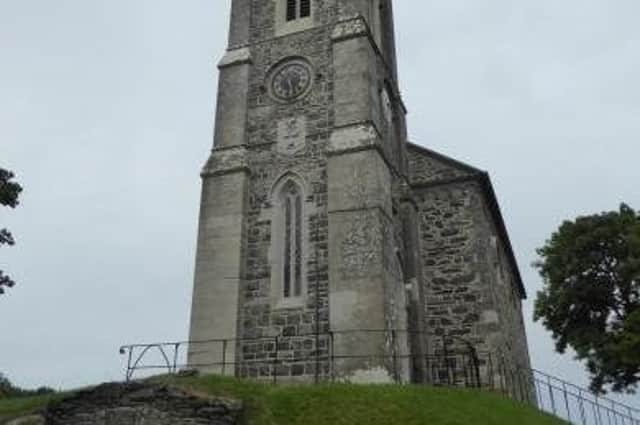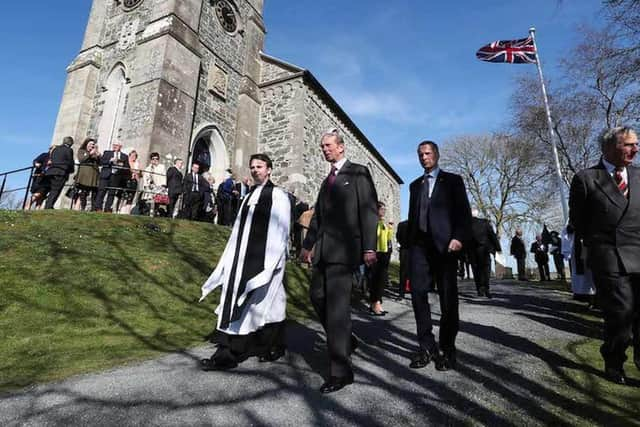Co Down church celebrating its bicentenary located on an ancient Christian site


Although St Mary’s Church, Kilmood, was opened for worship in 1822 and celebrates its bicentenary this year, the church was erected on a site long associated with Christian worship, going back perhaps to the era of St Patrick.
In 1306 the church at Kilmood was linked to the monastic settlement at Comber. After the dissolution of the monasteries the church on the site was linked to the parish of Hillsborough but by 1657 the building had fallen into ruins.
Advertisement
Hide AdAdvertisement
Hide AdThe building of the present church was financed by the Ecclesiastical Commissioners who contributed £900; Lord Dufferin, who gave the bell; and the local squire, David Gordon of Florida Manor, who paid the remainder of the £2,215 bill.


Kilmood was effectively an estate church. Florida Manor was established in 1638 on lands previously acquired by Sir James Montgomery (second son of Sir Hugh Montgomery) from Con O’Neill. The name Florida apparently was derived from Sir James’s love of flora rather than the American state or, more accurately, its precursor.
During the Cromwellian era the Manor was entrusted to the custody of a Colonel Barrow, but reverted to the Montgomery family in 1664.
The Crawfords, another Ulster-Scots family, purchased part of the estate from the Montgomerys of Rosemount, Greyabbey, in 1691.
Advertisement
Hide AdAdvertisement
Hide AdIn 1755, Robert Gordon married Alice Whyte, a widow and niece and sole heiress to the estate of David Crawford, and through this marriage the Gordons, yet another Ulster-Scots family, acquired Florida Manor. In 1797, David Gordon, son of Robert Gordon, succeeded to the estate on the death of his brother John Gordon.
For many years, the Gordons were the patrons of St Mary’s Kilmood, retaining the right to appoint the vicar. (Actually, it is possible this role alternated with the Marquess of Downshire.) The first vicar was the Rev James Crawford Gordon of Delamont, the younger son of David Gordon. In 1828 the Rev J C Gordon became Precentor of Down.
In 1837 Lewis’ Topographical Dictionary described the church as ‘an elegant structure in the later English style with a handsome tower and spire rising to a height of 120 feet’.
The spire is centred on the west gable and is three storey and has reducing buttressed piers to each corner rising to a castellated parapet with tall urn corner features.
Advertisement
Hide AdAdvertisement
Hide AdThe Gordon family papers indicate that the church was damaged in a storm in 1833, and in the famous ‘Great Wind’ of January 1839 the spire was blown off. The nave was re-roofed in 1907, and two years later the spire was the casualty of lightning, with 20 courses of stones blown off. When the spire was rebuilt in 1910-11, it was reduced in height.
Inside the church two plaques commemorate members of the Gordon family. The first commemorates David Gordon (who died in 1837) and his wife Mary (who died in 1836) and records that David Gordon’s ‘piety projected and whose liberality mainly contributed to the church’s erection and endowment’.
The second commemorates Robert Gordon (who died in 1864): ‘a magistrate and deputy lieutenant for the County of Down, in public life his strict justice and spotless integrity [and] in private life his steadfast affection, gentleness and sincere piety won him the esteem and love of all’.
The Roll of Honour for the 1914-18 War suggests an exceptionally high proportion of those listed made the supreme sacrifice.
Advertisement
Hide AdAdvertisement
Hide AdAnother striking feature of the church is the east window which may have been copied from or inspired by that of Salisbury Cathedral.
The graveyard predates the present church, with the earliest discernible headstone from 1793.
In addition to the erection of the new church, David Gordon was responsible for the construction of a school house, court house, cottages for labourers, as well as new buildings within the Florida demesne.
Lewis’ Topographical Dictionary offers commentary on the quality of the land in the parish: ‘The soil is generally fertile and the land in a high state of cultivation: there is very little waste land; and bog, as it becomes exhausted, is brought into cultivation.’
Advertisement
Hide AdAdvertisement
Hide AdIn 1831 the Ordnance Survey Memoir, compiled by Lieutenant G F W Bordes of the Royal Engineers, reveals that Mr Gordon was the proprietor of the townlands of Ballybunden and Ballykeel in the parish but the Marquess of Londonderry emerges as the parish’s major proprietor, being the owner of the townlands of Kilmood, Lisbarnet, Ballyminstra, Tullynagee and Ballygraffin.
Unfortunately, there is nothing about the culture of the people of the parish and comparatively little about religion – apart from the fact that Kilmood Parish Church attracted a congregation of ‘250, and sometimes 300 attendants’.
Both the Ordnance Survey Memoir and Lewis’ Topographical Dictionary are more informative about educational provision in the parish.
‘About 200 children are taught in four public schools; of these one, for which a handsome school-house was erected by Mr Gordon and the Marquess of Londonderry, is supported by the trustees of Erasmus Smith’s charity, who pay the master £30 per ann.; and one at Drumhirk was built and supported by Lord Dufferin.
Advertisement
Hide AdAdvertisement
Hide Ad‘There are also two private schools, in which are about 150 children.’
Lewis’ Topographical Dictionary also notes: ‘A mendicity society has been established, for raising funds to be applied to the relief or maintenance of the poor, which distributed at their own dwellings monthly; and an extensive religious lending library is kept in the court-house for the use of the poor.’
Three other points of interest deserve mention. The Rev John Moore, who was briefly the Vicar of Kilmood in the early 1830s, was responsible for creating the famous gardens at Rowallane, near Saintfield.
In 2018 new bells were installed at Kilmood and dedicated by Lord Eames, the former Archbishop of Armagh, to mark the centenary of the end of the Great War.
Advertisement
Hide AdAdvertisement
Hide AdThe following year the Duke of Kent visited Kilmood to attend a service to mark the unveiling and dedication of the church’s newly installed Walker pipe organ. The instrument is more than 100 years old and was restored after being rescued from a church in England.